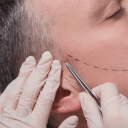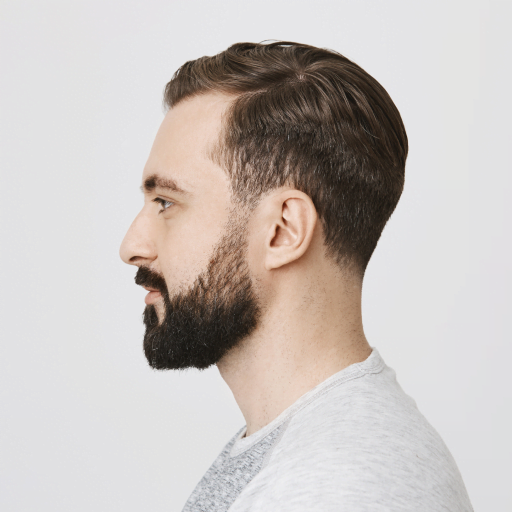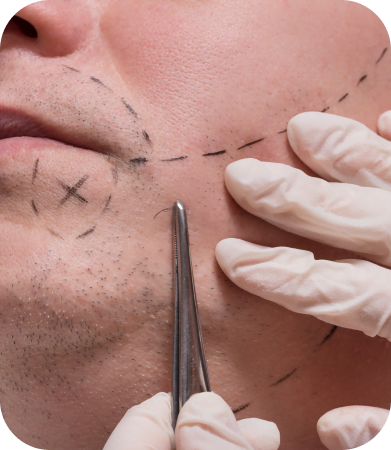FAQs About Facial Hair Transplants
How Does a Facial Hair Transplant Work?
Facial hair transplants use a procedure called follicular unit extraction (FUE). With FUE, your doctor will remove individual hair follicles from another area of your body. Typically, your doctor will take the follicles from an area of your scalp, though it is possible to take hair from the arms, legs, or chest.
Once the follicles have been removed, your doctor will numb the area of your face where the hair will be placed. They will make tiny incisions and place the follicles in the incisions. The incisions will heal, and the follicles will grow natural hair in the new location.
What To Expect During a Facial Hair Transplant Procedure
Facial hair transplants are done in the office, and you will be awake during the procedure. Your doctor will first shave the section of your scalp where they will be removing follicles. This allows them to see the follicles more clearly and choose follicles that will fit into the donor site. They will then conduct the harvesting process.
Once your doctor has collected follicles, they can begin transplanting them to your face. The duration of the procedure depends on the size of the transplant area. A full beard transplant may take up to 8 hours, while mustache transplants might take a shorter amount of time.
Facial Hair Transplant Cost
The cost of facial hair implants will vary. The size of the transplant area will affect the final cost. Your doctor will be able to give you a cost estimate when you have your consultation. Because hair transplantation is considered an elective cosmetic procedure, insurance will not cover the costs.
Recovery and Facial Swelling after Hair Transplant
Like any surgical procedure, you may have some pain and swelling at the incision sites. It’s not unusual to notice discomfort in the area where hair was extracted beginning a few hours after the facial hair transplant. Our team recommends using a cold pack or soothing lotion to ease discomfort and reduce swelling during recovery. The face swelling and pain should resolve within a few days of your procedure.
You may notice that the transplanted hair falls out about two weeks after the procedure. This is completely normal. The newly implanted follicular units will sprout new hair over the next several months. The cells may take some time to adjust to their new environment, but they will continue to encourage healthy hair development.
Facial Hair Transplant Before and After
The doctors at Hair Transplant NYC have performed many facial hair transplants. Our clients have been delighted with their results. Fuller eyebrows, beards, and mustaches help transform our clients’ appearances, helping them feel more confident as they navigate their daily lives.
Eyebrow Hair Transplant NYC
Facial hair transplantation isn’t just for people hoping to grow a fuller beard or mustache. The same procedure that increases hair volume for beards, mustaches, and hairlines can be used to increase the fullness of eyebrows.
Your doctor will begin by harvesting active follicles from a small area of your scalp. After that, your doctor can place individual follicles into your brows to replace lost or plucked hairs, fill in sparse areas, and create naturally fuller eyebrows.
Eyebrow Hair Transplant Cost
The cost of eyebrow hair transplants varies depending on the size of the area needing transplantation. Your doctor can give you an estimate for the procedure cost during your consultation.
Eyebrow hair transplantation is considered an elective cosmetic procedure, so your insurance plan will not cover it.
Eyebrow Hair Transplant Before and After
The doctors at Hair Transplant NYC have performed many eyebrow hair transplants. Clients have relied on us to replace eyebrows lost due to age, illness, or the effects of medications. Clients say they look and feel better after eyebrow hair transplants.
Eyebrow Hair Transplant Recovery Time
Like any surgical procedure, you may experience discomfort after the procedure. The most common symptoms are pain and swelling at the incision sites. You can apply a cold pack or soothing lotion to ease discomfort and reduce swelling. The swelling and pain should resolve within a few days of your procedure.
About two weeks after your eyebrow hair transplant, you may notice that the transplanted hair falls out. This is a completely normal part of the healing process. The newly implanted follicular units will begin to grow new hair over the next several months.
Facial Hair Transplant NYC
If you are considering a facial hair transplant in New York City, the doctors at Hair Transplants New York can help. Our experienced team of hair transplantation experts will help you get the results that you have always wanted. Call us today for a virtual consultation or to learn more about how we can help you.



